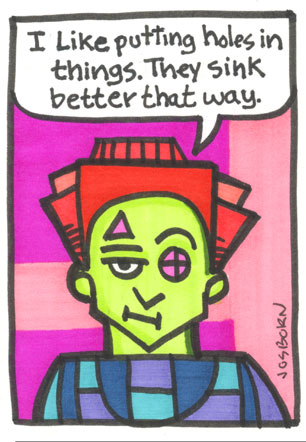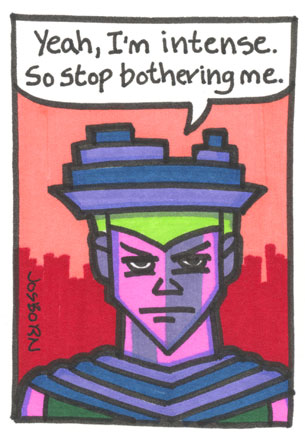I was working on my “Drifting and Dreaming” comic strip today. So far I’ve posted 399 of them over the years and a new one goes up every Sunday. I make them in batches so I can get ahead on them. The process of making the strips consists of a few distinct parts.
The first part is the part I was doing today. I was making a series of cartoon art cards. Those are my art cards that have a cartoon drawing of a person looking out at the reader with a word balloon above his or her head saying one thing or another. They’re simple enough to do but as I draw ten of them at a time it takes a lot of time and energy.
The first step is to draw them in ink. I don’t pencil them first because I want them fast and spontaneous. I use a Japanese sign pen that is inexplicably called a “Computer Pen.” A sign pen is your basic cheap marker that can be found in any drug store. I often use a Pentel sign pen for other stuff and that’s the one you can get at any local place that has a stationary section. I found the Japanese ones online and have used them ever since. I refill them with India ink so I get an even better line out of them but you don’t have to do that. I also like the tips after they’re worn down so refilling them helps with that. I draw the word balloon on top and then the character below it. I like to keep the characters fun and varied. I draw all sorts of crazy hair and head gear for them because that helps with the variety. Though they all my have a similar style I try not to repeat myself too much.
The second step is to write and letter them. I do that right on the cards. First I get out my Haff crosshatching machine and us it to make the guidelines for the lettering. The machine is a ruler attached to an arm and every time I push a button the ruler moves down from one to five millimeters depending on how I have it set. It’s a really easy way to make parallel lines. I make the guidelines on all ten cards and then set them out in front of me. That’s when write them.
“How do you write them?” you may ask and I’m not sure I have an answer for you. I stand there and think of things for my characters to say. Strange thing, odd things, and maybe witty things. I left words flow across my minds until I hear something I like. Sometimes I’ll even turn on a podcast or some such to hear other people talking and a word will catch my ear and I’ll make a sentence around it. It’s a weird process but eventually I get the cards written.
After I come up with what I want one character to say I letter the sentence in pencil on the card. Sometimes the sentence doesn’t fit and I have to rewrite it, erase the previous lettering, and re-letter it in pencil. Professional comic book letterers, back in the days of hand lettering, would go straight to ink and never pencil anything in. But they had the full script in front of them and lots of experience. I’m still writing at this point and need the freedom to erase. I repeat this process until I have all ten of them done and then I take a break.

I’m not a fan of doing hand lettering. I like to hand letter these cartoon art cards but I don’t enjoy the process. I’ve never been particularly good at it but the best advice I was ever given about lettering was to take a break. I tend to hurry my lettering because I want to get it done. I have to remember to slow down. I take a break if I find myself hurrying or frustrated. I’ve used various pens for lettering over the years but have never really settled on one.
Recently I’ve been using a .5mm black Copic fine line marker and it’s okay. I don’t love it but it does the job. I use the black marker to letter over the pencil lettering. Not exactly, of course, because the pencils were put down quickly and are just for spacing. I’m neater with the ink letters. I letter all ten of them in ink and them take a break to give the ink a chance to thoroughly dry. That way I can erase over them and remove the pencil letters. Some markers never thoroughly dry. Little bits of ink will smear when the eraser goes over them. That’s really annoying. Especially since a lot of pens that I like because they have exceptionally dark ink are the ones that will smear. I guess you can’t have everything.
The final step is to color the cartoon art cards. For some reason I find this step the most boring and tedious. Probably because at this point I just want to be done. I color them with my markers and its a simple process but it takes some time. I like to color all the backgrounds first. I find that helps me be less bored with the process. I use two different colors for each background and keep it simple but vary the colors. Often a light color on top and dark color on bottom but not always.

After all ten backgrounds are done I color each character one by one. I like to use wild color schemes and color their skin in odd colors. Often they get two tone skin. One by one I get them finished. After I finish them I scan them in. That’s pretty easy. Set them on the scanner and hit a button.
The other part of the writing for “Drifting and Dreaming” is done separately from the previous part. I write the part on the bottom of the strip, the “Middle Story,” on the computer in the strip’s template. I write ten of them. After they’re written I match the “Middle Story” up with two cartoon art cards and a third regular art card. How I match them up is a bit of a whimsy. I go with whichever ones jump out at me as I read them. Some work well together and some don’t. I have no explanations for that though.
This whole process always takes more out of my than I think it will. It’s familiar and straight forward so I always think it show be easier than it is. It takes about a six hour day to get ten cartoon art cards done. That’s five strips worth. I got ten done today and now I’m tired. I think I’ll go sit for a while.


Discussion ¬